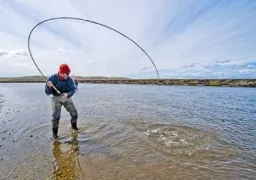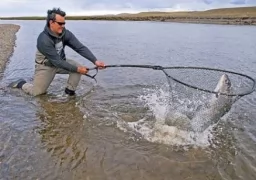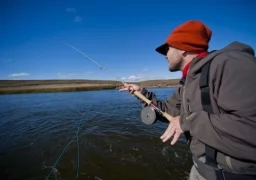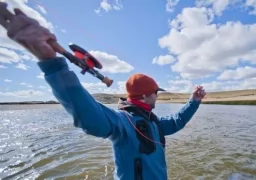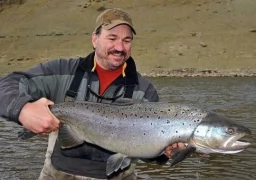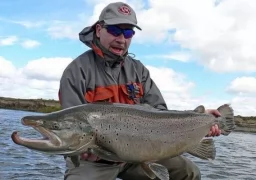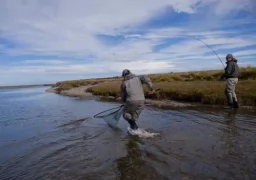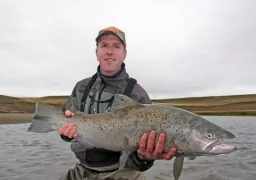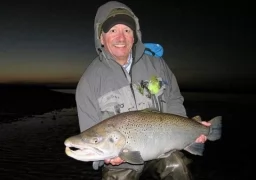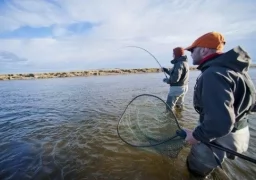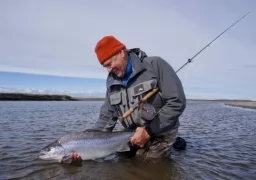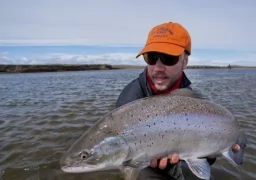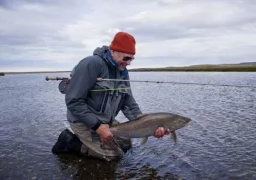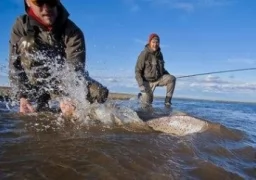CONTACT US+1 210 858 5443 / +54 9 358 576 6143
INTRODUCTION
Enjoy The Best Sea Run Brown Trout in Tierra del Fuego, Patagonia, Argentina!
Estancia Maria Behety fishing is, arguably, the best on the Rio Grande. The experience is highlighted by a diversity of water and sea trout angling challenges not available on other, more restrictive Rio Grande properties. Their talented, native, spey-savvy guides have a dawn-to-dusk work ethic and rank among the best in Argentina.
Sea Run Brown Trout
Time your trip for January, February, March, or the first two weeks of April.
Maria Behety Lodge is nearly 30 kilometers upstream from the entrance to this huge estancia. The location places guests within quick and easy striking distance of the very best pools of the Rio Grande. With more than thirty miles of exciting river available, you will likely have the best trophy water, every day, for your one-week stay.
Overview
Every serious angler deserves to hook a giant brown trout sometime in their life.
On the Rio Grande, it is an everyday experience!
Trout here are measured in kilos, not inches, and what makes this river different from all the others is that every cast into the Rio Grande might attract a strike from what would be the fish of a lifetime anywhere else!
“Never let a few facts get in the way of a good story” is a dictum trout fishermen swear by. In fact, most fish stories contain a certain amount of bullshit. The embellishment is often what makes them interesting, and the challenge of sorting fact from fiction in an angling tale is often as much fun as predicting the end of a Hitchcock movie.
Unfortunately for fishermen lucky enough to wet a fly line in Tierra del Fuego’s fabulous Rio Grande, most of the guesswork and a great deal of the skepticism surrounding their South American tales has been resolved by a three-year study conducted by the University of Montana Flathead Research Team, on what is commonly regarded as the “numero uno” trophy brown trout river on Earth.
Data collected from a remarkable number of fish caught and released during the three year study supports claims that don’t need exaggeration: The average size of brown trout in the Rio Grande is over nine pounds.
One in five trout is over fifteen pounds and one in fifty will be a “puerco del rio” that would tip the scales between twenty and twenty five pounds.
Statistically significant? Hell, during the 2008 season alone, there were some 5,039 sea-trout caught, weighed, measured, and tagged by anglers participating in the study.
The Fishing
It’s an action-packed itinerary that, without the afternoon siesta, would leave Superman feeling exhausted. Most anglers end every fish-weary day with a few memorable accent marks and some photographic proof of otherwise unbelievable trout. They’re eager to hit the sack and even more excited about what the fabulous Rio Grande might have to offer in the morning.
Most fish grab a streamer or nymph on the swing, the line draws tight, starts to hum and your first notion is you’ve hooked a log. There are damn few snags in the Rio Grande and when that three-foot long “snag” starts shaking its head, it’s time to plant your feet and get ready for a fight.
The Geography of the Rio Grande though most of the length of the Rio Grande is on the Chilean side of the border, nearly 80% of the prime spawning habitat and every inch of what is considered the best fishing is on the Argentina portion of the island, most in the first 45 miles above where the river meets the sea.
Maria Behety fences surround hundreds of square miles of grazing land and the huge estancia borders nearly 32 miles on the north bank of the river. Guests at the two Maria Behety lodges alternate daily the use of more than 50 kilometers (102 pools) with the four lodges on the opposite side of the Rio Grande in a friendly, organized rotation that insures a quality, private fly fishing experience for everyone.
The lodges on the southern shoreline are Kay Tapan, Despedida, Aurelia, and Villa Maria. The upstream estancias that separate Maria Behety and Kau Tapan from nearby Chile are bordered by increasingly shallow pools, marginal spawning habitat, and few sea trout.
Gear and equipment
For this amazing program it is very important to have the right equipment. Besides we can provide and rent you some tackle, we would like you to visit our website section regarding this specific issue in the section Lodges, and review Maria Behety Lodge info.
Catch and Release
BY CAREFULLY RELEASING A FISH, SURVIVAL RATES ARE VERY HIGH
To reduce fish mortality, anglers must handle fish carefully and quickly with appropriate technique. Always use a barbless fly while fishing the Rio Grande. This not only makes it easier to release the fish but is a safety precaution for both you and the guide. Whenever possible, we like to have the guides assist you in releasing fish. They are extremely efficient at it and thus will ensure the healthiest of releases. If a guide is not available to help you release a fish, please
FOLLOW THESE GUIDELINES:
1. Land the fish as quickly as possible; the longer the playing-time, the greater the stress on the fish.
2. If you can, it is best to remove the hook without handling the fish. However, it is often necessary to hold a fish during the hook removal process. Hemostats or a specialized release tool should be used to remove the hook.
3. When holding a fish, cradle it gently and horizontally in two hands. Turning the fish upside down will often disorient the fish and keep them calm long enough to remove a hook.
4. Keep hands and fingers away from the gills and do not put fingers over the eyes. Do not squeeze the fish in the throat or stomach regions as vital organs can easily be injured.
5. When photographing the fish, KEEP THE FISH IN THE WATER until the photographer is ready. Then take the photo quickly and put the fish back in the water. To help personalize this experience from the fish’s perspective, try holding you own breath whenever the fish is out of the water: try to imagine that you have just run a marathon and that your head is being forced underwater whenever the fish’s head is above it.
6. Never throw or kick a fish. Grasp it gently and return it carefully into quiet water deep enough to support it. Face the fish into the current and hold it in place so water can flow through its gills. DO NOT MOVE THE FISH BACK AND FORTH, as the backward movement forces water into its gills from behind – akin to having the wind knocked out of you. Revive the fish until it recovers enough to swim out of your hands on its own. (Seeing a fish swim out of your hands might be the moment of C & R’s maximum enjoyment!) Be patient, this may take more than a few minutes.
Whirling Disease and New Zealand mud snails
We recommend new or bleached boots to prevent the spread of whirling disease and New Zealand mud snails.
What is Whirling Disease?
Myxobolus cerebralis (Mc) is a parasite that infiltrates the head and spinal cartilage of fingerling trout where it multiplies rapidly, causing the fish to swim erratically and, in severe cases, die. When an infected fish dies, millions of tiny indestructible Mc spores (each about the size of a red blood cell) are released to the water where they can survive in this “dormant” form for up to 30 years. When Mc spores are ingested by Tubifex worms, the spore changes inside the worm and is released from the worm in a highly infective form, the Triactinomyxon (Tam).Tams are free-floating in the water until they infect trout, causing spinal deformities and decreased abilities for feed. Whirling disease is most infective to rainbow and cutthroat trout, but can infect all salmonid species.
WHIRLING DISEASEPREVENTION
Rinse all mud and debris from equipment and wading gear. Rinse, then thoroughly dry your boots, waders and other fishing equipment. This is generally sufficient to kill the TAM stage of the parasite.
Chlorine (regular household bleach) is a very effective disinfectant, and one of the few that can kill all stages of the parasite if used at the proper concentration. However, chlorine is a very strong chemical and can harm your equipment with prolonged exposure, so make sure you rinse the chlorine off your waders and other equipment after you disinfect, and dry in the shade.
To kill the TAM stage, use 1 part chlorine to 32 parts water. It must stay in contact for about 10 minutes to assure disinfection. To kill the mature myxospore that may be found in the mud from an infected stream is much more difficult and hard on equipment. 50% solution (1 part chlorine to 1 part water) - dip waders into a solution of the bleach or wipe or spray it on. 10% solution (1 part chlorine to 9 parts water) and soak your equipment for 10 minutes. Quaternary ammonium compounds are also effective in killing both parasite stages. These disinfectants are commercially available for disinfecting fishing equipment (Bright Water TM) or for the pet/veterinary trade (Roccal-D TM, Parvosol TM).
Equally effective is water heated to nearly boiling (200°F) poured over your gear and allowed to cool.
BACK TO TOP

